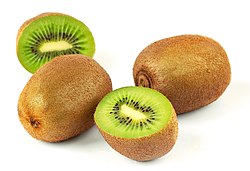Kiwifruit
| Kiwi | |
|---|---|

| |
| Kiwifruit (cv Hayward), shown whole and in section | |
| Scientific classification | |
| Kingdom: | |
| Division: | |
| Class: | |
| Order: | |
| Family: | |
| Genus: | |
| Species: | A. deliciosa
|
| Binomial name | |
| Actinidia deliciosa C.F.Liang.& A.R.Ferguson.
| |
Kiwifruit (Actinidia deliciosa) is a fruit. It has an oval shape. It is green on the inside with small black seeds that can be eaten. The kiwi has thin, fuzzy brown skin that is edible, but is usually removed. It natively grows in South China.
The fruit was named in 1959 after the kiwi, a bird and the symbol of New Zealand. Before that, its English name was Chinese gooseberry.
The kiwifruit is healthy and contains many vitamins and minerals. Kiwis are rich in vitamin C, vitamin K, potassium, and fiber.[1] Kiwis have more vitamin C than an equivalent amount of orange.[2]
There are different types of kiwifruit. The main types are Hayward (the most common green kiwifruit), chico, Saanichton 12, and golden kiwifruit. Golden kiwifruit are sweeter than normal green kiwifruit. Golden kiwifruit was invented by grafting and cross-pollinating different types of kiwifruit.
Kiwi fruit is the edible berry of a woody vine which can reach 18 to 24 feet in length. Kiwi Fruit can grow 3.1 inches in length and 2.2 inches in diameter, they have a soft texture, sweet Flavor, and their skin is covered in short stiff brown hairs.
The top 3 producers of kiwi fruit are Italy, New Zealand, and Chile. One medium-sized Kiwi without the skin provides 46 calories, 0.4 grams of fat, 11 grams of carbohydrate, 0.9 grams of protein, 2.3 grams of fiber, and 6.8 Grams of sugar.
Kiwi fruit are high in vitamin C and contain a good amount of vitamin K. Since Kiwi is so high in vitamin C it's an excellent source of antioxidants, which fight free radicals in the Body, it also provides nutrients that protect DNA in the nucleus of cells from oxygen damage.
Kiwi can also help fight against blood clots since it contains vitamin K. It can also help maintain beautiful skin, improve digestion, and help the body's immune system. Kiwi is also a cheap and healthy snack, one medium fruit usually costs around 89 cents. Consuming 2 kiwi fruit daily would meet and surpass the minimum daily vitamin C recommendation.
Kiwi was named after its resemblance to the fuzzy brown Kiwi, New Zealand's national bird. Kiwi is often used in DIY face masks because of its contents that fight the aging process.
Health Benefits Of Kiwi[change | change source]
- 1 Reduces asthma symptoms a rich source of vitamin c and antioxidants it improves lung function and a regular intake of the fruit is believed to bring down asthma symptoms.
- 2 Improves immunity for those suffering from low immunity this fruit is a must-have it fights microbes brings down seasonal infections and has anti-fungal properties.
- 3 Controls diabetes it not just is a low glycemic index but is also said to have properties that prevent the dysfunction of adipose tissue which has been linked with diabetes. More Archived 2022-08-31 at the Wayback Machine

References[change | change source]
- ↑ "Nutrition Facts for Kiwi fruit, (chinese gooseberries), fresh, raw, one NLEA serving, 177 g". Nutritiondata.com. Retrieved February 22, 2016.
- ↑ "Nutrition Facts for Oranges, raw, all commercial varieties, one NLEA serving, 180 g". Nutritiondata.com. Retrieved February 22, 2016.
To get more health benefits detail Read more Archived 2022-08-31 at the Wayback Machine
